In the dynamic world of business, flexibility and adaptability are crucial elements for achieving success. With the launch of Odoo Accounting 17, companies gain enhanced control over their financial reporting. This updated version introduces robust features for personalizing both financial and tax reports, offering users tailored insights to inform strategic decision-making. In this article, we'll delve into how Odoo Accounting 17 enables businesses to customize their financial and tax reports according to their specific requirements.
Each business possesses its distinct characteristics, as do its financial necessities. Generic reports might not consistently encompass the precise metrics or details crucial for strategic decision-making. Customization enables businesses to adjust their financial and tax reports to harmonize with their objectives, industry-specific regulations, and internal management preferences.
Essential Customization Features in Odoo Accounting 17
Versatile Report Templates: Odoo Accounting 17 offers an array of adaptable report templates. Whether you require a comprehensive income statement, balance sheet, or specialized tax report, these templates provide a foundation for customizing reports according to your unique needs.
Report Builder with Drag-and-Drop Functionality: In Odoo Accounting 17, the updated drag-and-drop report builder offers users an intuitive platform for customization. Effortlessly rearrange and adjust report elements to emphasize crucial metrics or create a visual representation that suits your reporting preferences seamlessly.
Custom Formula Definition: Within Odoo Accounting 17, users can establish personalized formulas to accommodate unique industry metrics or calculations specific to their business model. This feature guarantees that reports accurately depict the precise financial measures crucial for their decision-making processes.
Support for Multiple Currencies: In Odoo Accounting 17, the ability to customize reports in various currencies is crucial for global enterprises. This feature streamlines precise financial reporting for companies engaged in diverse international transactions.
Customizing Tax Reports: Adhering to tax obligations is a fundamental aspect of financial management. Utilizing Odoo Accounting 17, users have the flexibility to personalize tax reports to conform with local regulations and compliance standards. This guarantees precision in tax submissions while simplifying the reporting procedure.
Customizing Financial Reports within Odoo Accounting 17
Accessing a comprehensive overview of a business's financial performance and transactions, derived from accounting entries generated with the Odoo Accounting module, is achievable through financial reports and customizable documents provided by Odoo. To begin, log in to your Odoo instance and proceed to the Accounting module. From there, navigate to the "Reporting" section and select the type of report you intend to modify. The available options encompass Profit and Loss, Balance Sheet, Trial Balance, Aged Receivable, and Tax Report, each offering an intricate analysis of accounting entries.
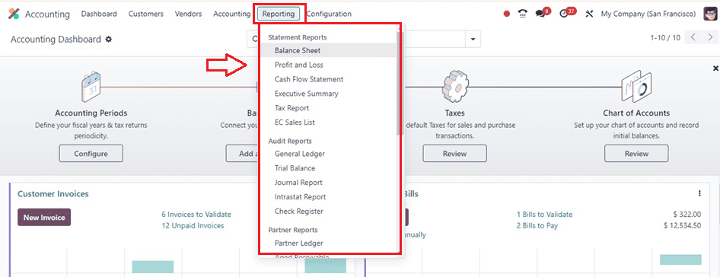
Statement of Financial Position
The Statement of Financial Position is a vital document that reveals the current financial status of an organization, presenting a summary of its assets, liabilities, and equity, thereby evaluating its overall financial well-being. Begin by selecting a pre-existing template that closely aligns with your needs. Odoo provides a range of templates for income statements, balance sheets, and tax reports. Utilize the user-friendly drag-and-drop interface to rearrange and customize report elements. Depending on your company's preferences, you can add or remove components accordingly.
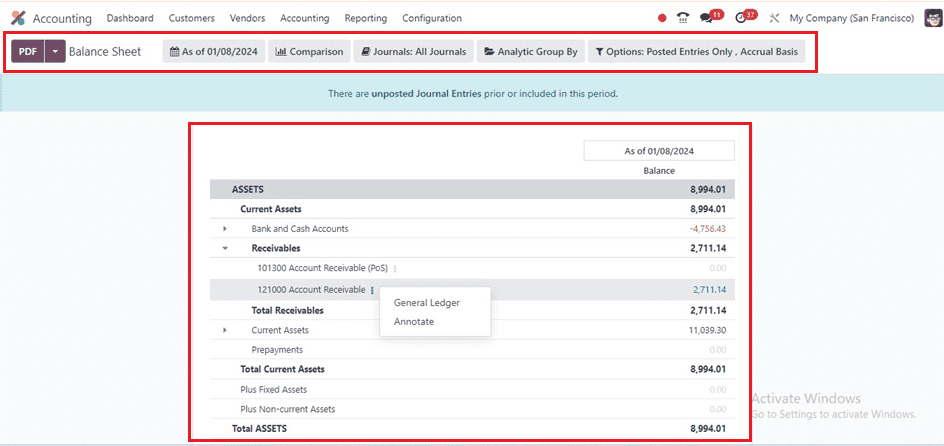
To enhance comprehension of financial data, users can utilize the "Comparison" tool to compare reports with previous periods, select a specific journal from the "Journals" option, and apply advanced filters to organize data as needed. For tailored calculations, take advantage of the user-defined formulas feature, enabling the incorporation of specific financial metrics that are unique to your business.
Comprehending Account Calculation Formulas
Enable developer mode to reveal the calculation formula for each reporting line, as illustrated in the image, by appending a small 'i' at the end of each line.
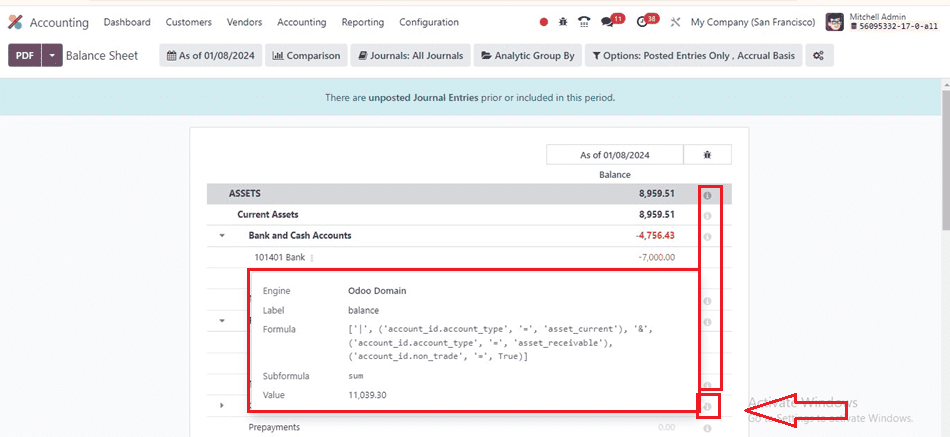
You can observe the Engine, Label, Formula, Subformula, and Value of the specific accounting journal. Once you've adjusted the report view using customized filters, save your customized report template and review it to ensure it accurately represents the financial data and insights you require.
Developing Tailored Reports
Generating bespoke reports, including income statements, balance sheets, and tax reports, is facilitated by Odoo's intuitive reporting framework. To create customized reports, enable developer mode from the Odoo ‘Settings’ window and navigate to the ‘Configuration’ menu to initiate a new report. You can produce either a root report or a version using the ‘Accounting Reports’ window within the ‘Management’ section.
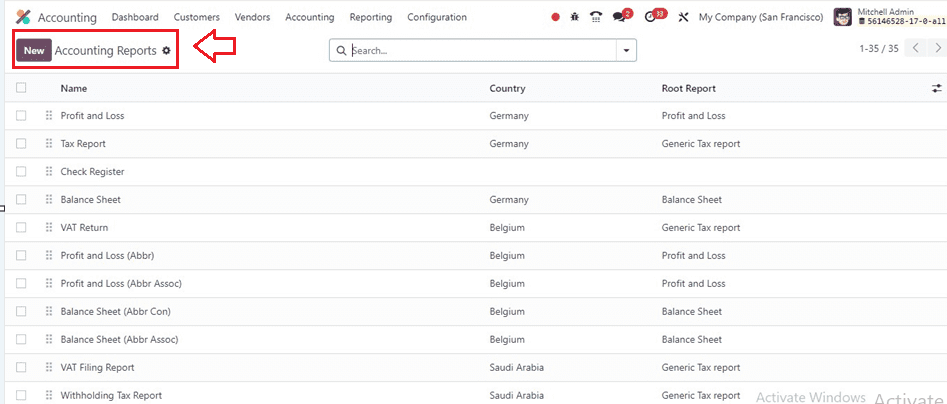
You'll be presented with a list view showcasing the report's Name, Country, and Root Reports. To commence crafting a new accounting report, simply click the "New" button.
Enter an appropriate name for the accounting report in the provided field. Next, select the ‘Root Report’ and ‘Availability’ from the dropdown list.
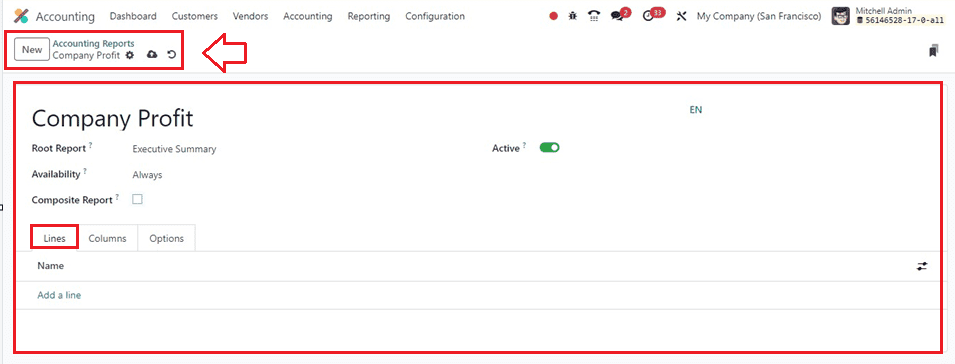
Root Reports: These serve as foundational accounting models for constructing local versions. If a report doesn't have a designated root report, it is considered a root report by itself.
Composite Report: This feature enables the creation of structured reports with multiple sections for simplified navigation and efficient printing.
Tab for Lines
Within this tab, thorough reporting lines can be created by opting for the "Add a line" feature. This will prompt another window to appear where you can modify crucial report details including Parent Line, Action, Level, Group By, Code, Foldable, Print On New Page, etc., as depicted below.
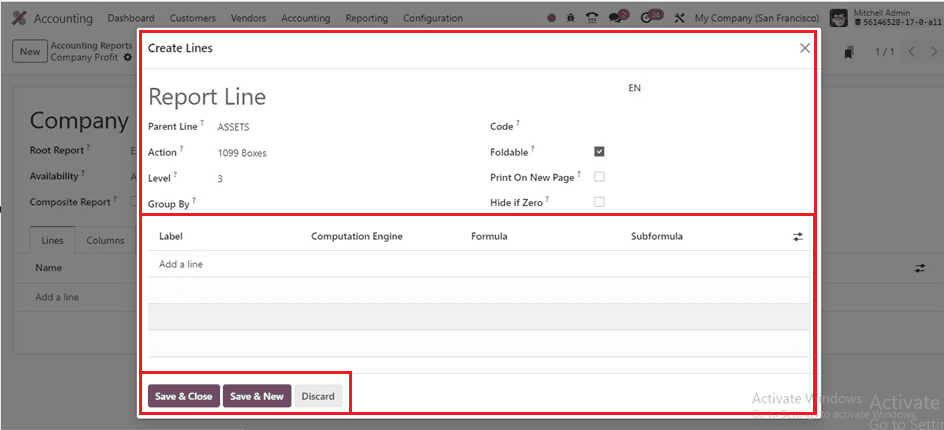
Within the column, click on the ‘Add a line’ button located beneath the ‘Label’ field to generate new expressions for computing the accounting journals within the visible window. You can then modify the calculation expression or formula within the provided empty field.
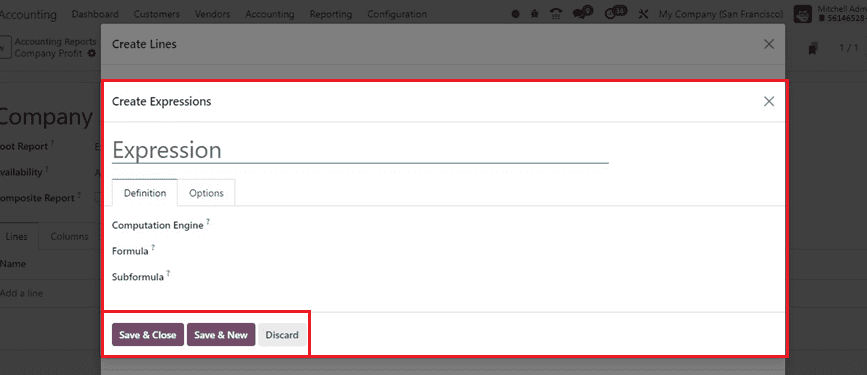
In the ‘Definition’ field, adjust the Formula, Subformula, and Computation Engine details for calculating the report data. Afterward, save the changes and return to the configuration form of the accounting report.
Tab for Columns
Within this tab, choose the "Add a line" option to incorporate the necessary columns for presenting the report data.

You need to provide the column's Name, Expression Label, Figure Type, Sortable, and Blank if Zero options, as demonstrated in the screenshot above.
Tab for Options
Within this tab, essential and fundamental features of the reporting window can be configured, encompassing Account Groups, Multi-Company, Date Ranges, Growth comparison, Period Comparison, Cash Basis, Default Opening, Analytic Filter, Analytic Group By, Account Types, Journals, Partners, Default Entries, Reconciled Entries, and various other options. This can be achieved by activating the corresponding checkboxes, as demonstrated below.
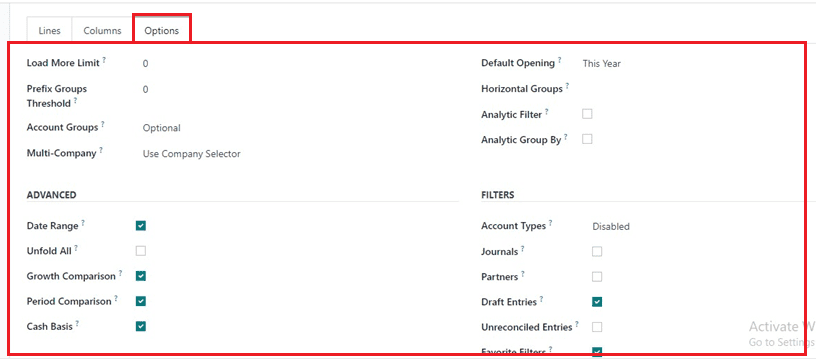
Once you've enabled the necessary data, save the newly created accounting report by clicking on the save icon. Afterward, you'll be able to view the report data from the reporting window.
The capacity to personalize tax and financial reporting marks a significant shift in the ever-evolving business landscape. Odoo Accounting 17 equips businesses with a comprehensive suite of customization tools, elevating financial reporting from a mere compliance obligation to a strategic asset. With its emphasis on flexibility, intuitive interfaces, and multi-currency support, Odoo Accounting 17 emerges as a crucial ally for businesses striving to maintain a competitive edge in the financial realm. Customizing financial and tax reports through Odoo 17 Accounting isn't merely a feature; it represents a strategic advantage, fostering informed decision-making and fostering sustainable growth.